Nature Conservation 2021 — 10. 6. 2021 — Nature and Landscape Management — Print article in pdf
Butterfly Conservation in the Era of Climate

Europe has considerably warmed up during the past decades, which is reflected in changes in the insect fauna. The most recognizable example is an expanding distribution range of the Praying mantis (Mantis religiosa), which has occupied, starting from the south, the whole of Moravia including the Jeseníky and Beskydy Mts during the 1990s, and has arrived in Bohemia via the Svitavy region. At present it occurs not only in Central Bohemian lowlands but also in the foothills of the Krkonoše/Giant Mts. or in the Bohemian-Moravian Highlands. Expanding butterflies include the Large copper (Lycaena dispar), which spreads at the same rate and in the same direction as the mantis, Great banded grayling (Brinthesia circe) and the Scarce swallowtail (Iphiclides podalirius).
Some expansions have been very recent. Examples include the Adonis blue (Polyommatus bellargus), which has been returning to eastern and central Bohemia from Moravia only in the past five years, and the Spotted fritillary (Melitaea didyma), which has been occupying its historic sites in southern Moravia since 2017. Some species are colonising new areas: e.g. the Short-tailed blue (Cupido argiades) has reached the north of Moravia. Other ones are completely new to the Czech Republic, the Eastern pale clouded yellow (Colias erate) already since the 1990s, and the European beak (Libythea celtis) since 2019. In a total, 20 diurnal butterflies display recent expansion in the Czech Republic. There are of course more nocturnal moths showing expansion. The probably most prominent are arrivals of the well-known migratory Death’s-head hawkmoth (Acherontia atropos) and the Oleander hawkmoth, known as the Army green moth (Daphnis nerii), whose numbers have been higher in the last decade than in the past fifty years.
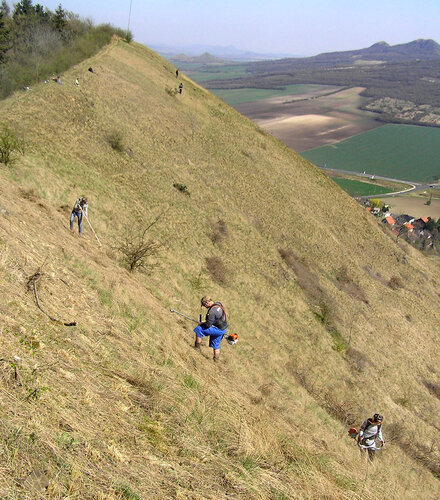
Volunteers working on rehabilitation management on Hermit
(Chazara briseis) habitat on the top of Raná Hill. © David Číp
Paradoxically, warming has a positive effect on species diversity. Since the number of species increases from north to south, there are more species profiting from warming than those driven to the north or into the mountains. Warming will however not solve the increasingly acute and pressing of insect extinction (cf. Čížek et al., Živa 5/2019, 247–250). In the past, the largest declines were seen in species of open-canopy forests, park landscapes and all non-forest vegetation types, i.e. habitats typical of the ‘ancient’ cultural landscape, which has been destroyed by industrialising farming on the Czech Republic´s territory in the past 150 years or so. Today mainly generalist species in southern regions expand to the Czech Republic. More specialised species, dependent on high-demanding management of their (often protected) habitats, do not spread there nor in neighbouring countries. Besides, also the abundance of hitherto common species has been declining.
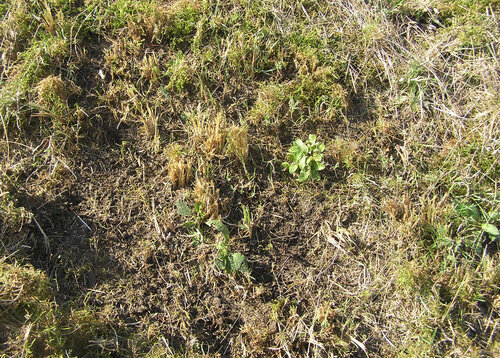
Detail of top parts of Raná Hill after rehabilitation management. © David Číp
North-south and altitudinal shifts in the distribution range of butterflies were the first evidence of the climate change influence on the occurrence of organisms (Parmesan et al., Nature 399, 579–583). Knowledge of the mechanisms of these changes also comes from Western Europe. Until the 1990s, the Silver-spotted skipper (Hesperia comma) had been very rare in Great Britain. Then an expansion to the north took place. It has been shown that larvae currently develop in different conditions than a few decades ago. The butterfly used to develop on south- or west-facing short grasslands. Today it prefers taller grassland, even on north- or east-facing slopes. The caterpillars still require the same microclimate, but that is found elsewhere in hot summers (Davies et al., J. Anim. Ecol. 75, 247–256). Similar changes were found for the Adonis blue by O’Connor et al. (Oecologia, 174, 1463–1472). It only used to live on the most arid calcareous rubble, but today it has occupied a wide range of grasslands. If the climate changed in a landscape rich in habitats, insects would not have a problem, but in the unified Central European landscape it is a problem.
Steppe habitats
The Hermit (Chazara briseis) used to be a common species of warm regions until the mid-20th century. Today it survives on a handful of volcanic hills in the České středohoří/Bohemian Uplands (northern Bohemia), belonging to one of the most endangered butterflies in the country. Before 2015, the Louny population was on the brink of extinction. Out of ten basalt mounds occupied in 2007 (Kadlec et al., Animal Conservation 13, 172–183) its occurrence shrank to a single one. LIFE+ projects and a regional action plan secured, besides resumption of grazing and recovery breeding for the transfer of individuals to former sites, also ‘horticultural’ site management, i.e. litter raking in short fescue grasslands used for larvae development. The situation started to improve, but then came the extreme heat waves and drought of the past few years. The top parts of Raná Hill, where the core population had developed during the past decade, completely lost its nectar sources indispensable for egg-laying females. The butterflies shifted to areas wetter and richer in flowers at the foot of the hills. If fescue grasslands outside the top parts of the Raná and Oblík hills had not been intensively restored, the drought in 2018–2019 would have been the final nail in the coffin of the Hermit.
The Damon blue (Polyommatus damon) has been becoming extinct everywhere in Central Europe. It has been lost in Poland, Slovakia and Hungary, and with the exception of the Alps also in Austria and Germany. Its food plant is sainfoins (Onobrychis spp.), a rather late flowering legume. The butterfly demands rather scrubby steppe grasslands and does not tolerate intense sheep grazing. In the Czech Republic, until 2005, it did well in the Hustopeče region (South Moravia), where it inhabited steppes with shrub encroachment near the village of Kurdějov. The site has received ‘European’ protection becoming a Site of European Importance (pursuant to Act No. 114/1992 Gazette on Nature Conservation and Landscape Protection, as amended later, the term for Site of Community Importance, SCI under the European Union’s Habitats Directive) targeted at the Red-flowered viper´s grass (Echium russicum), a herb of the earliest succession stages.
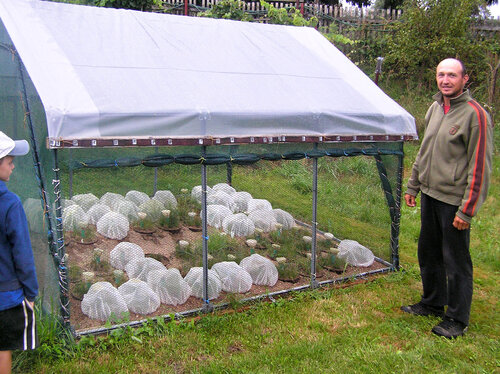
Outdoor facility for breeding endangered butterflies, including the Hermit. © David Číp
The broadminded delimitation of the Site of European Importance boundaries, far exceeding the occurrence of the bugloss, was among others motivated by the effort to cover the occurrence of the Damon blue. Unfortunately, site management has varied from one extreme to the other, inappropriate sheep grazing alternating with shrub encroachment. After the most promising population had been eliminated, the butterfly remained limited to three small populations, one in the Kyjov region (South Moravia) and two in the distant Lounské středohoří/Louny Uplands area in northern Bohemia. The Damon blue is regularly monitored and experiments with consolidating vegetation harbouring its host plant have been carried out. Nothing of this has helped because sainfoins desiccate at all sites in hot summers. In the České středohoří/Bohemian Uplands, in 2019, only a handful of imagoes survived, which fortunately managed to lay eggs on the host plants.
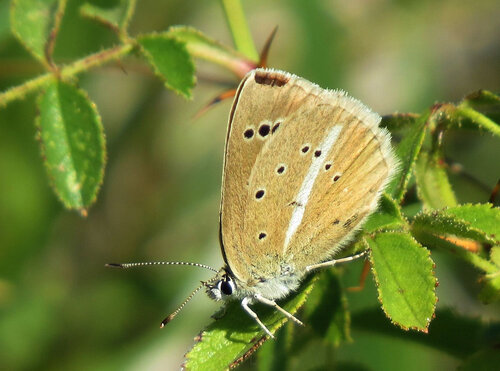
The Damon blue (Polyommatus damon). © Václav John
Drought also damages other blues whose larval development is associated with legumes, not only the rare Turquoise blue (Polyommatus dorylas) (developing in inflorescences of the Kidneyvetch Anthyllis vulneraria, only two populations in the Czech Republic), but also the much more widespread Chalk hill blue (Polyommatus coridon) (developing in inflorescences of the Purple crown vetch Securigera varia). Butterflies whose occurrence is concentrated in southern Europe and which should benefit from heat and drought, are disappearing before our eyes, but not everywhere. The decline in numbers of the Chalk hill blue has not been observed at higher elevations (e.g. the Sušicko-horažďovické vápence/Sušice-Horažďovice Limestones) or sites managed by early-spring grazing (e.g. Týnčanský kras/Týnčany Karst in Central Bohemia) and free all-year-round grazing (Milovice, reserve with large ungulates also in Central Bohemia). Spring grazing and mosaic mowing in spring, in contrast to summer mowing and grazing, allows rapid regeneration of the herb layer. Otherwise the steppe vegetation grows taller, desiccates completely in the summer and does not provide the blues with nectar or substrate for larval development.
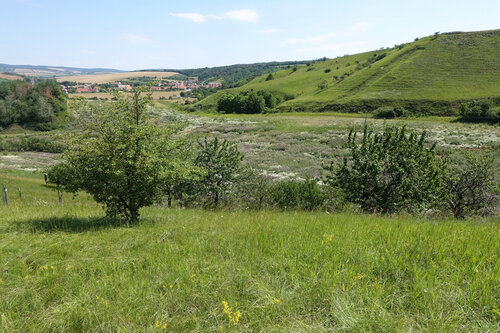
Na Adamcích National Nature Monument. © Jiří Beneš
Woodland habitats
Two species, one the most often mentioned by mass media the other the least explored, have seen an unexpected development. The Scarce fritillary (Euphydryas maturna), which has recently evoked many arguments among conservationists (Čížek & Konvička, Živa 6/2009, 271–273; Krása & Pavlíčko, Ochrana přírody 1/2014, 6–9), experienced a population boom in the area of the Dománovický les/Dománovice Wood in the Kolín region (Central Bohemia), its last site, in 2017 and 2018. It had allowed to take some individuals for controlled breeding and to transfer their offspring to the Libický luh/Libice Floodplain National Nature Reserve in 2018. The species had gone extinct there due to shading a long time ago, but today appropriate clearings are available. The following year the authors experienced a shock. The intensive monitored population at the Dománovický les/Dománovice Wood fell down to less than 10% of the previous year´s numbers. Declines in its populations occur commonly, but it is a guess why the 2019 decline was so deep. Higher population densities and extremely hot weather could have increased the rate of infection by parasitoids. In 2018, imagoes hatched two to three weeks earlier than in common years. In recovery breeding, the authors noticed the unique phenomenon that a third of the caterpillars developed into the last instar already in the summer (this normally happens in the spring of the following year), they pupated and produced a September imago generation. Even though nobody verified the situation in nature in autumn, such an autumn generation is lost for further reproduction because the butterflies cannot find enough nectar or substrate to lay eggs. Fortunately, the repatriated population at the Libický luh/Libice Floodplain established utself successfully. If the transfer had taken place just one year later this might never have succeeded.
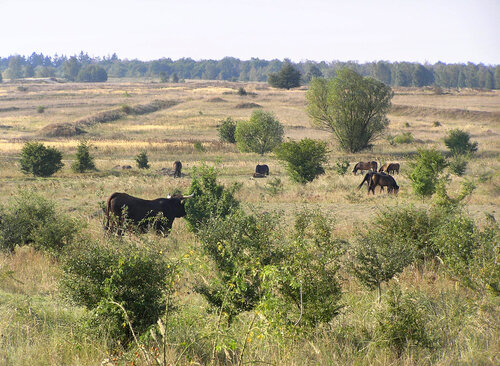
Free grazing by a mixed herd of horses and “aurochs” at Milovice,
southern pasture. © David Číp
The Rock grayling (Hipparchia alcyone), generally widespread in the warm Povltaví/Vltava River Basin and Předšumaví/Bohemian Forest Mts. Foothills regions 30 years ago, is surviving at a handful of sites in the surroundings of the Orlík and Slapy water reservoirs (Central Bohemia). The last sites where it occurred were open-canopy deciduous forests on steep slopes and some types of forest clearings and fringes. A well-prepared support programme (see https://motyli.csopvlasim.cz/) consists of thinning south- and west-facing forests, which the species preferred in former years. However, the year 2019 displayed the collapse also for this species. Despite an intensive search, only two individuals were recorded, each at another site. However, the sites where it occurs are varied and difficult to access, and the butterflies might have been rather hard to find (reduced activity or shift into tree crowns during hot weather). The question arises if clearings on sunlit slopes, which were earlier suitable for the species, are also suitable now when experiencing extremely hot weather conditions/heat waves. It may be necessary to create clearings also on slopes with a cooler exposure in the future, thus allowing butterflies to make a choice depending on the specific conditions of the year.
We could long continue in a similar way. The Scotch argus (Erebia aethiops) has vanished from the Povltaví/Vltava River Basin region, but has newly been found upstream of the Vltava River, in the Šumava/Bohemian Forest Mts. Foothills. Conversely, the critically endangered grayling (Hipparchia semele) was found to occur at most of its remaining sites in rather large numbers in 2019. It is a species of sands, rocks and similar habitats, which is very well adapted to temperature extremes, because their imagoes manage to survive the critical period thanks to aestivation.
Not only heat and drought reduce butterflies. Also the extremely cold and rainy month of May 2019 followed by an early start of the vegetation season must have had a negative impact. After the insects came to life, they suffered several weeks of hardship. If we have to predict, then 2020/2021 winter without deep frost and snow cover (causing repeated interruption of hibernation, which puts bioenergetic demands on species) will be comparably disastrous. These are drastic changes whose further course and direction cannot be predicted.
Climate change as an opportunity
The efforts to maintain residual populations by ‘horticultural’ management of their last sites are doomed to failure in the long term. All that we have learned so hard about the timing of mowing, dosing and timing of grazing, etc. is rapidly becoming obsolete. If we do not know how to manage a site, the only advice is to do it in a way as diversified as possible. However, the most valuable species survive at miniature sites. It is further typical of non-forest habitats that Specially Protected Areas often consist of the only single habitat. The Na Adamcích National Nature Monument (south-eastern Moravia), the last Moravian site of the Damon blue, is a 15-hectare steppe grassland. Until recently, it provided the blue and other xerophilous species with optimal conditions, but not anymore. In the former varied landscape, the blue would probably have moved on a bit, but today it has nowhere to go.
We must not give up, however. Species whose present response to a warmer climate worries us survived several warm periods of the Holocene in our regions. At the European level, they survived much more pronounced Quaternary climatic fluctuations. If the conditions deteriorated somewhere, appropriate new ones arose elsewhere. In the era of fast climate change, we must enforce nature conservation approaches allowing butterflies and other invertebrates to find climatically suitable habitats. Of the recommendations formulated a decade ago (Konvička et al., 2010, Butterfly conservation in the Czech Republic - An analysis of the present state and a long-term strategy, expert opinion for the Ministry of the Environment of the Czech Republic), the present ones do not differ in substance, but in urgency.
1. Expanding habitat management to the largest possible area
All the above-mentioned examples show that sites of endangered species cannot anymore be managed in a minimalist way or spotwise, i.e. by concentrating on areas or patches where the target species used to occur, reproduced or developed in the last few seasons. It is necessary to proceed more generously. Therefore, we have not to leave the principles of mosaic management and diversity. However, it implies that we will cut (graze, remove scrub, coppice, etc.) or, conversely, leave areas unmanaged on slopes of various exposures, on hilltops and in foothills, adjacent to or in the vicinity of the present populations´ distributions. Sometimes it will be appropriate to enlarge the current Specially Protected Areas with adjacent sites of lower quality, where diversified conservation management shall be introduced. This does not mean that small and isolated Specially Protected Areas will lose their importance, but we also urgently need large areas or a dense network of smaller sites.
2. Including new sites in the landscape in addition to protected ones
The national network of small-size Specially Protected Areas is so comprehensive in critical areas like south-east Moravia and the Elbe River lowlands that it cannot be expanded. And what is not protected is ‘de-insected’. Elsewhere, especially in mountain foothills, at least the most valuable sites have been protected. The current extent of Specially Protected Areas does nevertheless not provide enough space for sufficiently varied management necessary to preserve their species diversity. The Specially Protected Area network therefore needs to be complemented, not necessarily by legislative protection, but definitely by real conservation in the field. Opportunities are provided by areas where other activities have been abandoned, even on farmland, private and municipal land, by initiatives like Živá zahrada (Living Garden) and Pestrá krajina (Diverse Landscape), and by introducing management of biota along roads and other linear infrastructure. All these measures increase the density of potential habitat areas and stepping stones, even in intensively management landscapes, which are necessary to maintain the metapopulation dynamics of more sensitive species.
3. Working with nature in conservation management
The cases of the Hermit and the steppe blues have shown the importance of free year-round or early-spring grazing, which is much closer to nature than mowing or summer grazing in fenced enclosures. In the pre-industrial agricultural landscape, sites like municipal tracts were used by domestic animals continually, and rather in spring (when forage in the barns runs out) than in full summer. In pre-agricultural times, herbivorous ungulates alternated sunlit slopes in early spring and wetter habitats or higher elevations in summer. The cases of woodland butterflies demonstrate the importance of disturbance, clearings and open woodland of all types, not only at existing sites where rare insects occur. Their permanent presence is secured by return to forgotten management methods like coppicing or local rehabilitation of silvopasture as well as by prolongation of reforestation terms and more space for spontaneous shrub and tree succession (‘natural regeneration’ in forestry terms). The dying of forest plantations opens up unsuspected space. We should not see this as a tragedy, but as an opportunity.
4. Keeping the baseline in mind
Although it is seldom openly articulated, Central European nature conservation – perhaps with the exception of remote mountainous areas – has hitherto been related to the supposed state of the rural landscape before the onset of agricultural (and silvicultural) intensification. Our ideas about the appearance and dynamics of vegetation come from the 19th century, when the landscape type had begun to disappear. We have forgotten that the post-baroque landscape and its biota had developed through a millennium-long transformation of the Early Holocene landscape and that the pre-industrial era, just like the Early Holocene, were influenced by the presence of large animals – wild horses, aurochs and European bison. Not even the best active management can replace large animals completely. Free grazing at the Milovice former military training area in Central Bohemia, shows that year-round grazing by large animals supports butterflies (and other insects) in a way which cannot be achieved by other methods. It is no coincidence that Dalibor Dostál, author of the Milovice project, was awarded the Josef Vavroušek Prize in 2019 for excellent actions for the healthy environment and sustainable development. It is a pasture landscape – a diverse and dynamic ‘savannah’ rather than a uniform habitat – which should become the baseline for landscape and conservation activities. This is also true in places where we have to do without animals and replace them with technological tools.
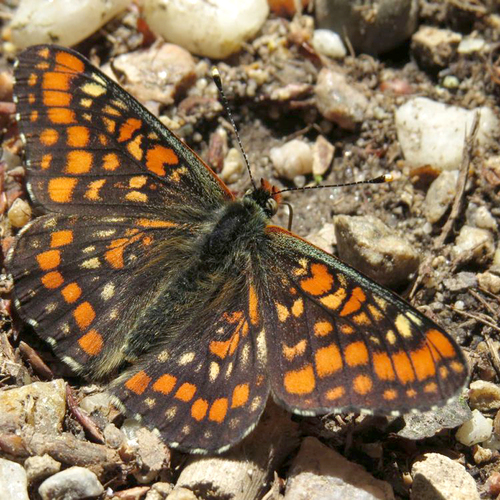
The Scarce fritillary (Euphydryas maturna). © Václav John
5. Working at the level of landscape components
Maintaining diversity and returning it to the landscape must really act together with the landscape, its history, function and potential. We should prepare conservation measures comprehensively, at the level of components like mountain ranges, catchment basins, river valleys and large-size protected areas (National Parks, Protected Landscape Areas, Nature Parks). Regional Action Plans (RAP) prepared by the Nature Conservation Agency of the Czech Republic for integrated conservation of species and populations, for which the national scale is unnecessarily large but the scale of particular sites is too small, are becoming an excellent new instrument.
6. Assisted colonisation: making room for translocations
If a species disappears for climatic reasons, it does not mean that no suitable climate for it has emerged somewhere else, on the opposite side of a river canyon slope, higher up in the mountains or further north. The state of the current landscape and of endangered populations unfortunately prevents new habitats to be colonised even when they are created somewhere else. For several years, the authors have warned about ill- conceived insect reintroductions and have absolutely refused transfers outside historic distribution ranges. However, climate and habitats change so quickly that translocations are gaining more and more importance for the maintenance of the Czech Republic´s natural heritage (Sedláček & Kadlec, Živa 6/2019, 306–308). It is high time to increase the capacity of recovery breeding, to support genetic screening of Central European biota, and to make reintroductions and transfers an effective tool for biodiversity conservation. Reintroductions and translocations must of course not be performed in a ‘wild’ manner. The objective should not be ill-conceived ‘enrichment’ of the natural world, but survival of most endangered species in the country.
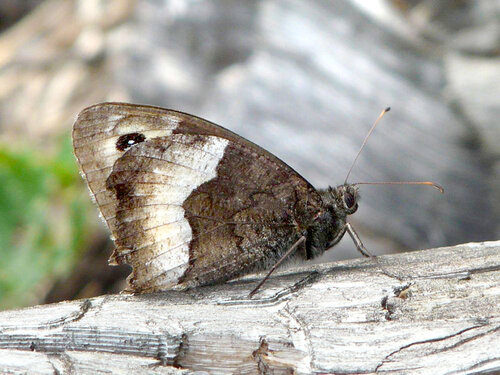
The Rock grayling (Hipparchia alcyone). © Václav John
If we want to protect butterflies in this time of fast climatic change, we need more and larger protected areas (or areas which we will treat as protected ones), more diversified, broadminded and generous management imitating the prehistoric pasture landscape, and greater effort to preserve populations, including reintroductions and transfers to suitable though unoccupied sites. All this may make insect conservation more expensive, but in the situation when climate change has hit a landscape heavily affected by intensification, there is no other way but to take it. It is becoming increasingly clear that refaunation of habitats by large herbivores is one of the biologically and economically most efficient approaches. When Donlan et al. (The American Naturalist, 168, 1–22) described refaunation plans as an ‘optimistic agenda for the 21st century’, they consider that the restoration of completely functional ecosystems can give them back their dynamics and return species their evolutionary potential. These are aspects which come to the forefront during rapid change in climatic conditions.
The project was supported by Technology Agency of the Czech Republic grant SS01010526 and from the Academy of Sciences pf the Czech Republic Strategy AV21 Programme Záchrana a obnova krajiny (Landscape Preservation and Restoration).

